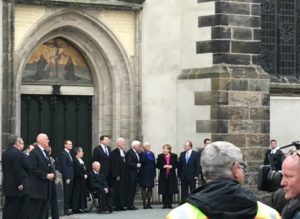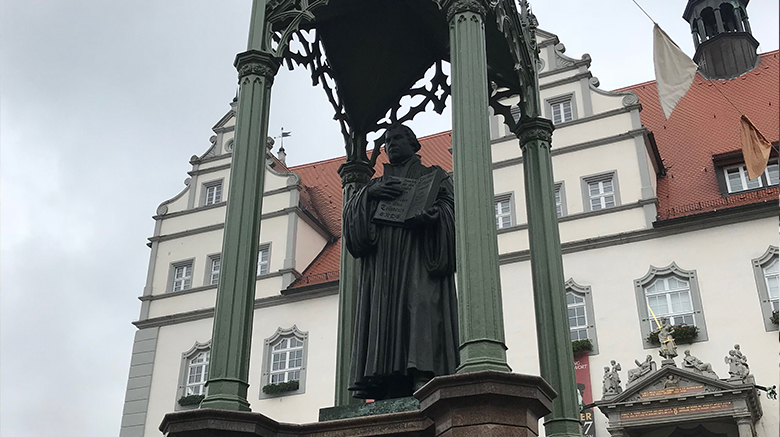 I arrived in Wittenberg at 10 a.m., and already the small town in eastern Germany was full of people. As I got off the train and walked toward the town, I was surrounded in a wave of people, all there to celebrate Martin Luther and the start of the Protestant Reformation. As I walked along College Street, I saw stalls selling handmade crafts, food and beer brewed in Saxony. When I got to the Marktplatz in the city center, I could see more stalls and musicians all surrounding a statue of Luther. To the right is the City and Parish Church of Saint Mary, where Luther delivered many homilies and speeches. Behind the statue is the town hall. And to the far left is Castle Church where Luther nailed his 95 theses 500 years ago.
I arrived in Wittenberg at 10 a.m., and already the small town in eastern Germany was full of people. As I got off the train and walked toward the town, I was surrounded in a wave of people, all there to celebrate Martin Luther and the start of the Protestant Reformation. As I walked along College Street, I saw stalls selling handmade crafts, food and beer brewed in Saxony. When I got to the Marktplatz in the city center, I could see more stalls and musicians all surrounding a statue of Luther. To the right is the City and Parish Church of Saint Mary, where Luther delivered many homilies and speeches. Behind the statue is the town hall. And to the far left is Castle Church where Luther nailed his 95 theses 500 years ago.
The Lutherhaus boasted having over one thousand works that dealt with the Reformation, as well as the Counter-Reformation. These works ranged from printed pamphlets to indulgence letters, paintings and statues, as well as objects that have been used in the past to celebrate every centennial since the Reformation. As I walked through the Lutherhaus, I heard people singing “A Mighty Fortress is Our God,” one of the most important songs from the Protestant Reformation (see note below).
 The German Chancellor Angela Merkel arrived in front of Castle Church at 3 p.m., along with other foreign dignitaries, for a mass held in the church. They walked into the church, going through the doors that Luther had nailed his theses on in 1517. Later at the nearby Catholic Church of the Immaculate Conception, a concert played religious music from the Renaissance era.
The German Chancellor Angela Merkel arrived in front of Castle Church at 3 p.m., along with other foreign dignitaries, for a mass held in the church. They walked into the church, going through the doors that Luther had nailed his theses on in 1517. Later at the nearby Catholic Church of the Immaculate Conception, a concert played religious music from the Renaissance era.
At night, projectors had the words Freedom, The Word of God, Sola Gracia, Sola Fide, Sola Scriptura and many others projected onto the buildings around the Marktplatz and Castle Church. This day was a truly rewarding experience for me because I was able to both deepen my knowledge of Reformation history, as well as enjoy the festival celebrating the 500th anniversary of Luther and the Reformation.
Note: Luther believed that people should sing the praises of God in their churches, and he encouraged people to sing. Songs were extremely powerful because they were able to spread a political message. At that time, an overwhelming majority of people could not read or write, so songs were one of the best ways that Luther’s message could spread to the common man. The printing press also helped spread his ideas. Pamphlets had become cheap because of the mass production created by the printing press, and many people from the lower classes could buy pamphlets. Printed pamphlets, such as Erhalt uns Herr bei deinem Wort, had a picture showing Luther and other Protestants with Jesus being saved from damnation. Pamphlets such as these were able to attract a large number of followers to Lutheranism.
500 years ago today Luther supposedly nailed his 95 Theses to this door at the Castle Church. pic.twitter.com/PHMIUJcwjt
— SJCNYGlobal (@SJCNYGlobal) October 31, 2017


